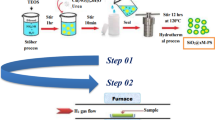Abstract
V2O5-WO3/TiO2 catalyst was poisoned by impregnation with NH4Cl, KOH and KCl solution, respectively. The catalysts were characterized by X-ray diffraction (XRD), inductively coupled plasma (ICP), N2 physisorption, Raman, UV-vis, NH3 adsorption, temperature-programmed reduction of hydrogen (H2-TPR), temperature-programmed oxidation of ammonia (NH3-TPO) and selective catalytic reduction of NO x with ammonia (NH3-SCR). The deactivation effects of poisoning agents follow the sequence of KCl>KOH≫NH4Cl. The addition of ammonia chloride enlarges the pore size of the titania support, and promotes the formation of highly dispersed V = O vanadyl which improves the oxidation of ammonia and the high-temperature SCR activity. K+ ions are suggested to interact with vanadium and tungsten species chemically, resulting in a poor redox property of catalyst. More importantly, potassium can reduce the Brønsted acidity of catalysts and decrease the stability of Brønsted acid sites significantly. The more severe deactivation of the KCl-treated catalyst can be mainly ascribed to the higher amount of potassium resided on catalyst.
Similar content being viewed by others
References
Busca G, Lietti L, Ramis G, Berti F. Chemical and mechanistic aspects of the selective catalytic reduction of NOx by ammonia over oxide catalysts: a review. Applied Catalysis B: Environmental, 1998, 18(1–2): 1–36
Alemany L J, Lietti L, Ferlazzo N, Forzatti P, Busca G, Giamello E, Bregani F. Reactivity and physicochemical characterization of V2O5-WO3/TiO2 de-NOx catalysts. Journal of Catalysis, 1995, 155(1): 117–130
Shi A J, Wang X Q, Yu T, Shen M Q. The effect of zirconia additive on the activity and structure stability of V2O5/WO3-TiO2 ammonia SCR catalysts. Applied Catalysis B: Environmental, 2011, 106(3–4): 359–369
Chen J P, Yang R T. Role of WO3 in mixed V2O5-WO3/TiO2 catalysts for selective catalytic reduction of nitric oxide with ammonia. Applied Catalysis A: General, 1992, 80(1): 135–148
Kröcher O, Elsener M. Chemical deactivation of V2O5/WO3-TiO2 SCR catalysts by additives and impurities from fuels, lubrication oils, and urea solution I. Catalytic studies. Applied Catalysis B: Environmental, 2007, 75: 241–253
Chen L, Li J H, Ge M F. The poisoning effect of alkali metals doping over nano V2O5-WO3/TiO2 catalysts on selective catalytic reduction of NOx by NH3. Chemical Engineering Journal, 2011, 170(2–3): 531–537
Tang F S, Xu B L, Shi H H, Qiu J H, Fan Y N. The poisoning effect of Na+ and Ca2+ ions doped on the V2O5/TiO2 catalysts for selective catalytic reduction of NO by NH3. Applied Catalysis B: Environmental, 2010, 94(1–2): 71–76
Kamata H, Takahashi K, Odenbrand C H I. The role of K2O in the selective reduction of NO with NH3 over a V2O5(WO3)/TiO2 commercial selective catalytic reduction catalyst. Journal of Molecular Catalysis A: Chemical, 1999, 139(2–3): 189–198
Lisi L, Lasorella G, Malloggi S, Russo G. Single and combined deactivating effect of alkali metals and HCl on commercial SCR catalysts. Applied Catalysis B: Environmental, 2004, 50(4): 251–258
Zheng Y J, Jensen A D, Johnsson J E. Laboratory investigation of selective catalytic reduction catalysts: deactivation by potassium compounds and catalyst regeneration. Industrial & Engineering Chemistry Research, 2004, 43(4): 941–947
Zheng Y J, Jensen A D, Johnsson J E, Thøgersen J R. Deactivation of V2O5-WO3-TiO2 SCR catalyst at biomass fired power plants: elucidation of mechanisms by lab- and pilot-scale experiments. Applied Catalysis B: Environmental, 2008, 83(3–4): 186–194
Putluru S S R, Jensen A D, Riisager A, Fehrmann R. Alkali resistivity of Cu based selective catalytic reduction catalysts: potassium chloride aerosol exposure and activity measurements. Catalysis Communications, 2012, 18: 41–46
San José-Alonso D, Illán-Gómez M J, Román-Martínez M C. K and Sr promoted Co alumina supported catalysts for the CO2 reforming of methane. Catalysis Today, 2011, 176(1): 187–190
Tikhomirov K, Kröcher O, Wokaun A. Influence of potassium doping on the activity and the sulfur poisoning resistance of soot oxidation catalysts. Catalysis Letters, 2006, 109(1–2): 49–53
Larrubia M A, Busca G. An ultraviolet-visible-near infrared study of the electronic structure of oxide-supported vanadia-tungsta and vanadia-molybdena. Materials Chemistry and Physics, 2001, 72(3): 337–346
Ramis G, Yi L, Busca G. Ammonia activation over catalysts for the selective catalytic reduction of NOx and the selective catalytic oxidation of NH3: an FT-IR study. Catalysis Today, 1996, 28(4): 373–380
Wan Q, Duan L, Li J H, Chen L, He K B, Hao J M. Deactivation performance and mechanism of alkali (earth) metals on V2O5-WO3/TiO2 catalyst for oxidation of gaseous elemental mercury in simulated coal-fired flue gas. Catalysis Today, 2011, 175(1): 189–195
Gazzoli D, De Rossi S, Ferraris G, Mattei G, Spinicci R, Valigi M. Bulk and surface structures of V2O5/ZrO2 catalysts for n-butane oxidative dehydrogenation. Journal of Molecular Catalysis A: Chemical, 2009, 310(1–2): 17–23
Bulushev D A, Rainone F, Kiwi-Minsker L, Renken A. Influence of potassium doping on the formation of vanadia species in V/Ti oxide catalysts. Langmuir, 2001, 17(17): 5276–5282
Huang S J, Liu S L, Zhu Q J, Zhu X X, Xin W J, Liu H J, Feng Z C, Li C, Xie S J, Wang Q X, Xu L Y. The effect of calcination time on the activity of WO3/Al2O3/HY catalysts for the metathesis reaction between ethene and 2-butene. Applied Catalysis A: General, 2007, 323: 94–103
Erdőhelyi A, Németh R, Hancz A, Oszkó A. Partial oxidation of methane on potassium-promoted WO3/SiO2 and on K2WO4/SiO2 catalysts. Applied Catalysis A: General, 2001, 211(1): 109–121
Author information
Authors and Affiliations
Corresponding author
Rights and permissions
About this article
Cite this article
Wu, X., Yu, W., Si, Z. et al. Chemical deactivation of V2O5-WO3/TiO2 SCR catalyst by combined effect of potassium and chloride. Front. Environ. Sci. Eng. 7, 420–427 (2013). https://doi.org/10.1007/s11783-013-0489-0
Received:
Accepted:
Published:
Issue Date:
DOI: https://doi.org/10.1007/s11783-013-0489-0




